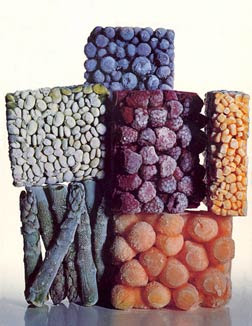Irvin Penn had taken a picture of foods that appeared to be nothing more than a couple of blocks of frozen fruits and vegetables all stacked on top of one another. This, although being the actual display held such an immense amount of meaning for me. When I took a moment and pondered at the possible reasoning to have taken a picture of frozen foods it immediately occurred to me that one of the biggest ideas trying to be conveyed by the image was the idea of change and progression. Thinking back to other paintings that I had seen, there always seemed to be a handful of paintings using fresh fruit and vegetables as the center of the work. I’m sure everyone can relate to those paintings having food such as fruit and bread in a basket, but the main difference between those paintings and Penn’s photograph was the fact that his were frozen as compared to being fresh. Relating back to the idea of change and progression; society has progressed and shifted in such a way that anything frozen is as natural to us as it being fresh. Looking at the image with this idea in mind it isn’t too different than all of those generic paintings with the fruit and other foods in the basket in the sense that in both cases the food itself serves as the main center of attraction and is often organized in a specific way. Before the foods would lay scattered throughout the display in a neat but not necessarily organized manner as compared to the frozen food Penn had taken an image of, being in rough edged box like shapes. It could be possible that the image also represented our society’s change in order and conduct over the years where it use to be more relaxed as compared to now where it could be viewed as being cold, extremely rigid, and in a way almost lifeless much like the frozen foods. The fact that the work of art is also a photograph as compared to a painting could also further support the idea of society’s evolution with time because rather than being painted it was taken with a camera showing how art and expression in themselves are also changing aspects of our society as time continues to pass. While art was often viewed as being a painting or sculpture it has now become subject to many different forms of expression defining it in such a unique way.
-Shujat Khan


Photograph by Irvin Penn Painting by Barbara Wells





















